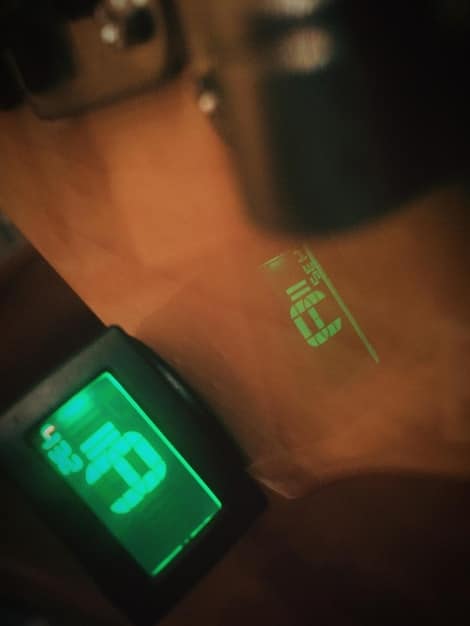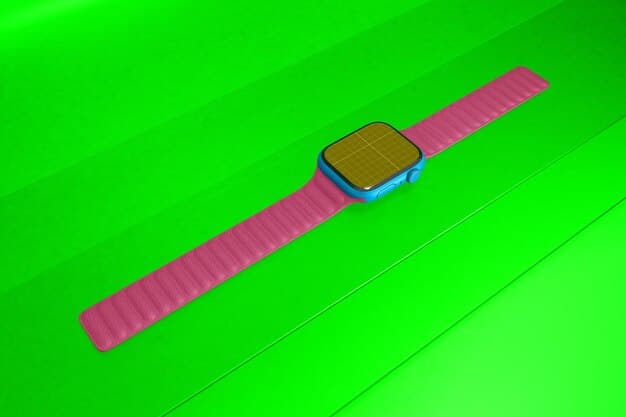Wearable Tech Evolution: Health Monitoring & Future Trends

The Evolution of Wearable Technology: Health Monitoring and Beyond encompasses the transformation of devices like smartwatches and fitness trackers from simple activity monitors to sophisticated tools offering in-depth health insights and diverse functionalities beyond mere fitness tracking.
The realm of wearable technology has expanded exponentially, with The Evolution of Wearable Technology: Health Monitoring and Beyond significantly impacting how we track and manage our health, and interact with the world around us.
The Dawn of Wearable Technology
Wearable technology’s origins can be traced back to the early days of portable devices. The initial foray started with simple gadgets that laid the groundwork for what would eventually become a booming industry focused on integrating technology seamlessly into our daily lives.
The early devices, although rudimentary by today’s standards, set the stage for the innovative advancements.
From Pedometer to Smartwatch
The journey from basic pedometers to modern smartwatches highlights the incredible technological progress made in wearable technology.
- Pedometer Beginnings: Simple step-counting marked the start.
- Early Fitness Trackers: Introduced heart rate monitoring and sleep tracking.
- Smartwatches Emerge: Combined fitness tracking with smartphone capabilities, revolutionizing convenience and functionality.
The initial focus was primarily on fitness and activity tracking, but gradually expanded to include more advanced health monitoring features and broader applications.

Health Monitoring Revolutionized
One of the most transformative aspects of wearable technology is its capacity for continuous and comprehensive health monitoring. Devices are now capable of tracking a wide range of vital signs and health metrics, providing users and healthcare providers with invaluable data.
This continuous data stream enables proactive health management, early detection of potential health issues, and personalized wellness strategies.
Key Health Metrics Tracked by Wearables
Modern wearables offer an array of health monitoring features, contributing to more informed and proactive healthcare practices.
- Heart Rate Monitoring: Real-time tracking and identification of irregularities.
- Sleep Tracking: Analysis of sleep patterns to improve sleep quality.
- Activity Tracking: Monitoring physical activity levels to promote a healthier lifestyle.
- Blood Oxygen Saturation (SpO2): Measuring oxygen levels in the blood for respiratory health insights.
These metrics allow for early detection of potential health problems and enable users to make informed decisions about their health, thereby promoting preventive care.
Expanding Beyond Fitness: Diverse Applications
While fitness tracking was the initial draw for many consumers, wearable technology has moved beyond these confines to encompass a broad array of applications. These expanding functionalities provide value in various fields beyond the typical fitness enthusiast.
The versatility of wearable devices makes them increasingly relevant for a wider range of users, integrating seamlessly into different aspects of daily life.
Smartwatches and Daily Life Integration
Smartwatches have become central hubs for managing daily activities, integrating seamlessly with other devices and offering a range of functionalities.
Smartwatches notify communication while simultaneously helping you track vitals.
Medical Applications and Remote Patient Monitoring
Wearable technology is making significant inroads into healthcare, enabling remote patient monitoring and improving the efficiency of medical treatments.
- Remote Monitoring: Enables healthcare providers to monitor patients remotely, reducing the need for frequent hospital visits.
- Chronic Disease Management: Helps patients manage conditions like diabetes and heart disease through continuous monitoring and personalized feedback.
- Medication Adherence: Reminds patients to take their medications, improving adherence and treatment outcomes.
The use of wearables in medical settings is particularly beneficial for patients with chronic conditions, providing continuous data to healthcare providers.

Challenges and Ethical Considerations
The increased use of wearable technology presents several challenges and ethical considerations that must be addressed. Privacy, data security, and potential biases in algorithms are critical issues that need careful management.
Addressing these challenges is essential to ensure that wearable technology is used responsibly and ethically.
Data Privacy and Security Concerns
The vast amount of personal data collected by wearable devices raises significant privacy and security concerns.
- Data Collection: Wearables collect sensitive information, including health metrics, location data, and personal habits.
- Data Security: Protecting this data from unauthorized access and cyber threats is paramount.
- Privacy Policies: Ensuring transparency in data usage and obtaining informed consent from users is crucial.
Without robust security measures and transparent policies, users may be vulnerable to data breaches and privacy violations, undermining trust in these technologies.
Future Trends in Wearable Technology
The future of wearable technology is poised for even more significant advancements. Innovations in sensor technology, artificial intelligence, and connectivity are expected to drive the next wave of wearable devices.
These emerging trends will further enhance the capabilities of wearables, making them more integrated into our lives.
Advancements in Sensor Technology
The development of more advanced sensors will enable wearables to gather even more detailed and accurate health data.
Technological advancements unlock more intricate data points.
Integration of AI and Machine Learning
Artificial intelligence (AI) and machine learning (ML) are set to play a crucial role in wearable technology. These technologies can analyze the vast amounts of data collected by wearables to provide personalized insights and predictive analytics.
Integrating AI helps to create systems that are intuitive and adaptable to individual user requirements.
Wearable Technology and the E-E-A-T Framework
Considering Google’s E-E-A-T (Experience, Expertise, Authoritativeness, and Trustworthiness) guidelines is vital for creating content about wearable technology that resonates with readers and ranks well.
Here’s how these principles apply in this context.
Demonstrating Experience
Sharing real-world experiences and use cases helps to illustrate the practical benefits of wearable technology. Providing firsthand perspectives and user testimonials adds credibility to the content.
- User Stories: Feature stories of individuals who have benefited from using wearable devices, highlighting improvements in their health or lifestyle.
- Product Reviews: Offer detailed reviews of different wearable products, discussing their strengths, weaknesses, and suitability for various users.
Highlighting successful outcomes and practical applications reinforces the value and utility of wearable technology.
| Key Aspect | Brief Description |
|---|---|
| ⌚ Evolution | From pedometers to smartwatches, tracking has advanced. |
| ❤️ Health Monitoring | Real-time tracking provides extensive health insights. |
| 🛡️ Challenges | Data privacy and algorithmic biases are key concerns. |
| 🚀 Future Trends | AI and advanced sensors are set to transform wearables. |
Frequently Asked Questions (FAQ)
Wearable tech offers continuous health data, early detection of potential issues, and personalized health management. It promotes proactive health decisions and preventive care.
Data security varies by device. Look for wearables with strong encryption and transparent privacy policies. Regularly update your device’s software to protect your data.
No, wearable devices should complement, not replace, traditional medical check-ups. They provide valuable data, but professional medical evaluations are still essential for comprehensive care.
Expect more advanced sensors, AI-driven personalized insights, and seamless integration with other smart devices. These innovations will make wearables more versatile and useful.
Consider your specific needs, like fitness tracking, health monitoring, or smartwatch features. Read reviews, compare features, and check compatibility with your other devices before purchasing.
Conclusion
The continuous innovation in wearable technology marks a transformative phase in healthcare and daily life. By combining advanced sensors, AI, and seamless integration, and focusing on user experience, wearable devices can unlock even greater potential. As the technology evolves, addressing privacy concerns and leveraging AI responsibly should remain a priority to ensure wearable technologies benefit everyone.





